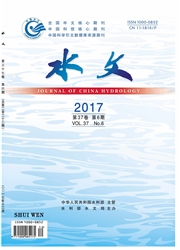

 中文摘要:
中文摘要:
传统的投影寻踪回归(PPR)的矩阵表示法用于水质评价,当指标较多时,不仅优化参数矩阵元的学习效率低,而且优化效果亦受到影响。若适当设置3类水体(地表水、地下水和富营养化水体)各指标的参照值及指标值的规范变换式,使不同指标的同级标准的规范值差异不大.从而可以认为用规范值表示的不同指标皆与某个规范指标“等效”。因此,只需构造并优化得出对各指标规范值都共同适用的2个指标变量的NV—PPR(2)和3个指标变量的NV—PPR(3)模型,对于指标变量较多的NV—PPR建模,只需将其分解为若干个NV—PER(2)和(或)NV—PPR(3)的组合表示即可。对模型的实用性进行的效果检验表明:基于指标规范变换的3类水体的水质评价的投影寻踪回归模型具有形式简洁、计算简便和普适通用的特点。
 英文摘要:
英文摘要:
Traditional projection pursuit regression represented with matrix, which is applied in water quality evaluation for multi-index, affects not only learning efficient of optimized parameter matrix element, but also optimal effects. The present work set the proper reference values and transformed forms for each index. Therefore, the different in the same grade standard values with different index could be weakened after the normal transformation, the normalized values of different indexes were e- quivalent to a certain normalized index. Therefore, it is only necessary to set up the models of NV-PPR (2) and NV-PPR(3) suited to 2 indexes and 3 indexes, respectively, for each normalized index values. Meanwhile, the optimization of the parameter matrix elements of model were iterated by monkey-king genetic algorithm. Furthermore, the multi-index NV-PPR model could be represented into the combinations of some NV-PPR (2) and (or) NV-PPR (3) models. The practicality of models was verified virtually. The results showed that the projection pursuit regression model of water quality evaluation based on normal- ized index transform exhibited the characteristics of simplicity in form, convenience during calculation, university as well as commonness.
 同期刊论文项目
同期刊论文项目
 同项目期刊论文
同项目期刊论文
 期刊信息
期刊信息
